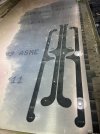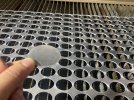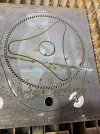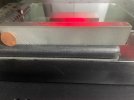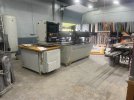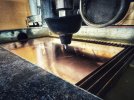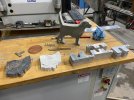Waterjet work is another service we offer.
A brief explanation of how it works is as follows. Water is treated so that is very pure and cold. It’s pure to the point it would probably give you a head ache if you drank it. It’s also cold so the water is not boiling inside the pump.
Our machine has a 30 hp electric motor that is connected to a high pressure water pump. The machine flows less than 1 gallon on water per minute but at 50,000 psi. Once it comes out of the nozzle the water is moving at approximately twice the speed of sound. A special sand known as garnet is introduced at the top side of the nozzle and the sand does all the cutting. The water is just the medium to transport sand.
Waterjets are useful because they will cut any steel a knife maker will encounter and cut nearly all materials. There are about 8 materials in the world they can’t cut, a bunch of materials you don’t want to get wet such as cardboard or plywood. There are also some materials that are too brittle like tempered glass. Sometimes there is a work around for sensitive materials but for the knife maker this is purely academic.
Our machine is sized correctly for knife makers and will accommodate a piece of steel 24”X48” and a little bigger if I disable the soft limits. There are bigger and more powerful machines out there with 200+ hp pumps and 90,000 psi but they are used for cutting very thick materials and you will actually end up with a more expensive knife blank. We do have a tilting head for taper control but from my experience on thin material (under 1” thick) it actually makes a worse part that cost more. So for the knife maker this is always disabled.
We cut a ton of steel with ours…. We also cut a ton of G10 and Micarta with some different settings and restrictions.
The main reason to use waterjet is to avoid a heat affected zone on expensive steels. On some high chromium steels; lasers can have trouble because the steel is very reflective. The waterjet simply does not care what the steel is. It only cares about the thickness.
A brief explanation of how it works is as follows. Water is treated so that is very pure and cold. It’s pure to the point it would probably give you a head ache if you drank it. It’s also cold so the water is not boiling inside the pump.
Our machine has a 30 hp electric motor that is connected to a high pressure water pump. The machine flows less than 1 gallon on water per minute but at 50,000 psi. Once it comes out of the nozzle the water is moving at approximately twice the speed of sound. A special sand known as garnet is introduced at the top side of the nozzle and the sand does all the cutting. The water is just the medium to transport sand.
Waterjets are useful because they will cut any steel a knife maker will encounter and cut nearly all materials. There are about 8 materials in the world they can’t cut, a bunch of materials you don’t want to get wet such as cardboard or plywood. There are also some materials that are too brittle like tempered glass. Sometimes there is a work around for sensitive materials but for the knife maker this is purely academic.
Our machine is sized correctly for knife makers and will accommodate a piece of steel 24”X48” and a little bigger if I disable the soft limits. There are bigger and more powerful machines out there with 200+ hp pumps and 90,000 psi but they are used for cutting very thick materials and you will actually end up with a more expensive knife blank. We do have a tilting head for taper control but from my experience on thin material (under 1” thick) it actually makes a worse part that cost more. So for the knife maker this is always disabled.
We cut a ton of steel with ours…. We also cut a ton of G10 and Micarta with some different settings and restrictions.
The main reason to use waterjet is to avoid a heat affected zone on expensive steels. On some high chromium steels; lasers can have trouble because the steel is very reflective. The waterjet simply does not care what the steel is. It only cares about the thickness.

